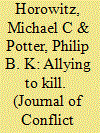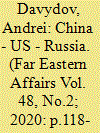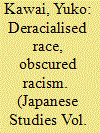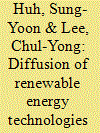|
|
|
Sort Order |
|
|
|
Items / Page
|
|
|
|
|
|
|
| Srl | Item |
| 1 |
ID:
128975


|
|
|
|
|
| Publication |
2014.
|
| Summary/Abstract |
Terrorist organizations do not operate in isolation. Instead, they forge alliances with one another, which generate a tight network of intergroup relationships. We argue that these relationships serve to increase group capacity, manifesting itself in the ability of a group to conduct deadly attacks. However, groups are notably judicious when they forge these cooperative ties, preferring to link to the strongest groups to which they have access. The result of this process of preferential attachment is a core/periphery structure in the broader network of alliances. Moreover, groups with ties to organizations at the core of the broader universe of relationships reap more rewards than those with large numbers of less meaningful alliances. Terrorism research and counterterrorism policy should assess terrorist organizations in the broader context of their interrelationships and depth of alliances rather than in isolation.
|
|
|
|
|
|
|
|
|
|
|
|
|
|
|
|
| 2 |
ID:
174543


|
|
|
|
|
| Summary/Abstract |
This article describes the recent events in the relations between China, the United States, and Russia (the "Big Three" in the struggle to shape a new world order), their role and potentialities in the process under conditions of the raging coronavirus pandemic, and the development prospects for their relations in the foreseeable future.
|
|
|
|
|
|
|
|
|
|
|
|
|
|
|
|
| 3 |
ID:
140344


|
|
|
|
|
| Summary/Abstract |
This paper examines the interrelationships among Japaneseness, the Western and Japanese concepts of race, and the obfuscation of racism in contemporary Japanese society. The concept of race, which was conceived in the West in the modern era, has influenced the Japanese concepts of race, jinshu and minzoku. These two concepts played a key role in constructing modern Japan’s identity by distinguishing it from its significant discursive Others: Asia and the West. Today the Japanese simply call themselves nihonjin, or Japanese people, rarely using the terms jinshu and minzoku, and racism is generally viewed as a ‘foreign issue’ that has little relevance to Japanese society. The purpose of this study is threefold. First, it discusses how the Japanese concepts of race, jinshu and minzoku, were constructed and shaped the dominant meaning of the Japanese in different historical contexts, intertwining with Western notions of race, nation, Volk, and ethnicity. Second, it suggests that obscured racism in contemporary Japan is linked with the conceptual presence and nominal absence of jinshu and minzoku in defining Japaneseness. Third, it explores how the contemporary modality of racism in Japan overlaps with and differs from racisms in the West.
|
|
|
|
|
|
|
|
|
|
|
|
|
|
|
|
| 4 |
ID:
132658


|
|
|
|
|
| Publication |
2014.
|
| Summary/Abstract |
Renewable energy technologies (RETs) have attracted significant public attention for several reasons, the most important being that they are clean alternative energy sources that help reduce greenhouse gas emissions. To increase the probability that RETs will be successful, it is essential to reduce the uncertainty about its adoption with accurate long-term demand forecasting. This study develops a diffusion model that incorporates the effect of competitive interrelationships among renewable sources to forecast the growth pattern of five RETs: solar photovoltaic, wind power, and fuel cell in the electric power sector, and solar thermal and geothermal energy in the heating sector. The 2-step forecasting procedure is based on the Bayus, (1993. Manage. Sci. 39, 11, 1319-1333) price function and a diffusion model suggested by Hahn et al. (1994. Marketing Sci. 13, 3, 224-247). In an empirical analysis, the model is applied to the South Korean renewable energy market.
|
|
|
|
|
|
|
|
|
|
|
|
|
|
|
|
|
|
|
|
|